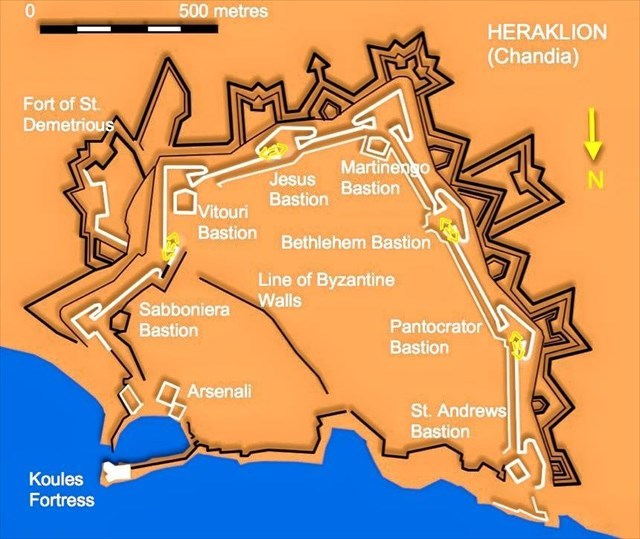By the early years of the First Byzantine Period (330-840 AD), Heraklion already had fortifications, which were supplemented by both Arab conquerors (840-961 AD) and the Byzantines (961-1204 AD), and subsequently by the Venetians after 1211 AD. But the looming threat from the Turks forced Venice to fortify the capital city of Regno di Candia with the most modern techniques available at the time. The fortifications in the form we can see today are based on the plans of the chief engineer, Michele Sanmicheli. They were built sometime around the period 1462-1560. The main wall was three kilometers long. It had four gates, and seven bastions surrounded by a wide moat. The outer side had ramparts which no longer exist today. The fortifications of Heraklion were considered not only in terms of size but also because of their aesthetic and functional perfection, to be the most important of the eastern Mediterranean.
The northwest corner of the walls hosted the bastion of St. Andrew, the weakest of Candia.
The Turks conquered Heraklion, then known as the Great Castle, in 1669, after 21 years of siege (May 29, 1648 - September 18, 1669), due to the betrayal of the Venetian Andrea Barozzi, entering from the bastion of ST Andreas (St Andrew). The siege of the town was one of the longest in world history.
Nowadays, the Bastion of St Andreas is a popular place for a walk and a rest among the local people as it offers the best view to the Heraklion Bay and the Cretan Sea.
The cache is a plastic micro container hidden on the walls in the area of the bastion. Please, search in stealth mode and hide it with caution. Don’t forget your pen!
The closest access onto the walls to the bastion is given as Trailhead.

Το Ηράκλειο ήδη από τα χρόνια της Α’ Βυζαντινής Περιόδου (330-840 μ.Χ.) διέθετε οχυρώσεις οι οποίες συμπληρώθηκαν τόσο από τους Άραβες κατακτητές (840-961 μ.Χ.) και τους Βυζαντινούς (961-1204 μ.Χ.) όσο και από τους Βενετούς μετά το 1211 μ.Χ. Η διαφαινόμενη όμως απειλή των Τούρκων υποχρέωσε τη Βενετία να οχυρώσει με τον πλέον σύγχρονο για την εποχή τρόπο την πρωτεύουσα του Regno di Candia. Η μορφή των οχυρωματικών έργων που βλέπουμε σήμερα έχει βασιστεί σε σχέδια του αρχιμηχανικού M. Sanmicheli και κατασκευάστηκαν την περίοδο 1462-1560 περίπου. Το κυρίως τείχος είχε μήκος τρία χιλιόμετρα και διέθετε τέσσερις πύλες και επτά προμαχώνες που περιβάλλονται από μεγάλη τάφρο και στην εξωτερική της πλευρά διέθετε επιπρομαχώνες οι οποίοι δε σώζονται σήμερα. Τα οχυρωματικά έργα του Ηρακλείου θεωρούνται τόσο σε ότι αφορά το μέγεθος τους αλλά και την αισθητική και την λειτουργική τους τελειότητα, από τα σημαντικότερα της ανατολικής Μεσογείου.
Στη βορειοδυτική γωνία του τείχους, υπήρχε ο προμαχώνας του Αγίου Ανδρέα, ο μικρότερος του Χάνδακα. Το 1648 τα οθωμανικά στρατεύματα εμφανίστηκαν μπροστά στα τείχη της πόλης. Η πολιορκία του ισχυρού οχυρού υπήρξε από τις λίγες με τόσο μεγάλη διάρκεια στην παγκόσμια ιστορία, αφού κράτησε 21 ολόκληρα χρόνια (1648-1669). Καθοριστικό ρόλο στην κατάκτηση της πόλης έπαιξε η προδοτική στάση του συνταγματάρχη του μηχανικού Andrea Barozzi, ο οποίος αποκάλυψε στον εχθρό τα αδύνατα σημεία των οχυρώσεων.
Σήμερα ο προμαχώνας του Αγίου Ανδρέα είναι δημοφιλής τόπος για βόλτα και ανάπαυλα, αφού είναι το καλύτερο μπαλκόνι της πόλης με θέα στον κόλπο του Ηρακλείου και το Κρητικό Πέλαγος.
Η κρύπτη είναι ένα μικρό πλαστικό κουτάκι κρυμμένο πάνω στα τείχη στην περιοχή στου προμαχώνα. Επειδή το μέρος είναι πολυσύχναστο, παρακαλώ ψάξτε με τρόπο και ξανακρύψτε την πολύ προσεκτικά. Μην ξεχάσετε το στυλό σας!
Η κοντινότερη πρόσβαση στον προμαχώνα του Παντοκράτορα δίνεται ως σημείο.
